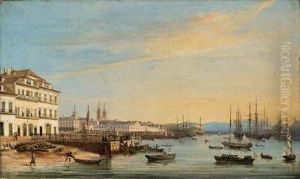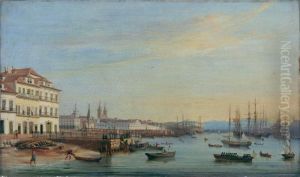Adolphe D'Hastrel Paintings
Adolphe D'Hastrel de Rivedoux, born on January 30, 1805, in Paris, was a French artist, naval officer, and ethnographer known for his contributions to the art world in the 19th century. He was part of the Romantic movement that swept through Europe, which was characterized by an emphasis on emotion and individualism as well as glorification of the past and nature.
D'Hastrel began his career as a naval officer, which provided him the opportunity to travel extensively. These voyages greatly influenced his artistic work, as he often depicted scenes from the locations he visited. He was particularly intrigued by the landscapes and cultures of the places he encountered during his naval expeditions, and this curiosity was reflected in his art and writings.
After retiring from the navy, D'Hastrel devoted himself more fully to his artistic pursuits. He was a versatile artist, working in various mediums including drawing, painting, and lithography. His subjects ranged from landscapes and seascapes to detailed ethnographic representations. He had a particular interest in the depiction of costumes and customs of different peoples, which he encountered during his travels, and this became a significant aspect of his artistic legacy.
D'Hastrel's ethnographic work extended beyond the canvas; he was also an author who wrote about the cultures he studied, contributing to the field of ethnography. His combination of visual art and written descriptions provided a rich, multifaceted perspective on the customs and lifestyles of various ethnic groups, particularly those from the regions he visited in the Mediterranean and Asia.
Throughout his life, D'Hastrel exhibited his works in various salons, and his art was well received by critics and the public alike. His detailed and colorful representations offered viewers a glimpse into distant lands and foreign cultures, which were of great interest during a time when travel was not as accessible as it is today.
D'Hastrel passed away on June 13, 1874, in Pau, France. Although he may not be as widely known today as some of his contemporaries, his works remain a valuable historical record of 19th-century ethnography and art. His paintings and writings continue to be studied by those interested in the intersection of art, travel, and the study of cultures.





![Rio De Janeiro Dessine Du Sommet Du Corcovado [1841]](https://www.niceartgallery.com/imgs/506379/s/adolphe-dhastrel-rio-de-janeiro-dessine-du-sommet-du-corcovado-1841-664ef712.jpg)